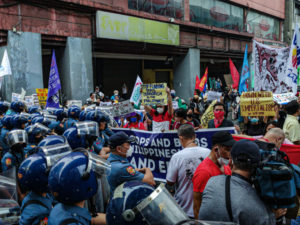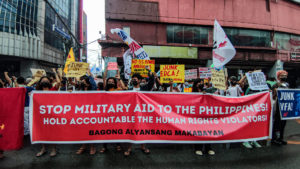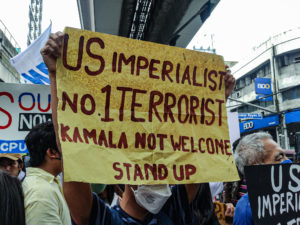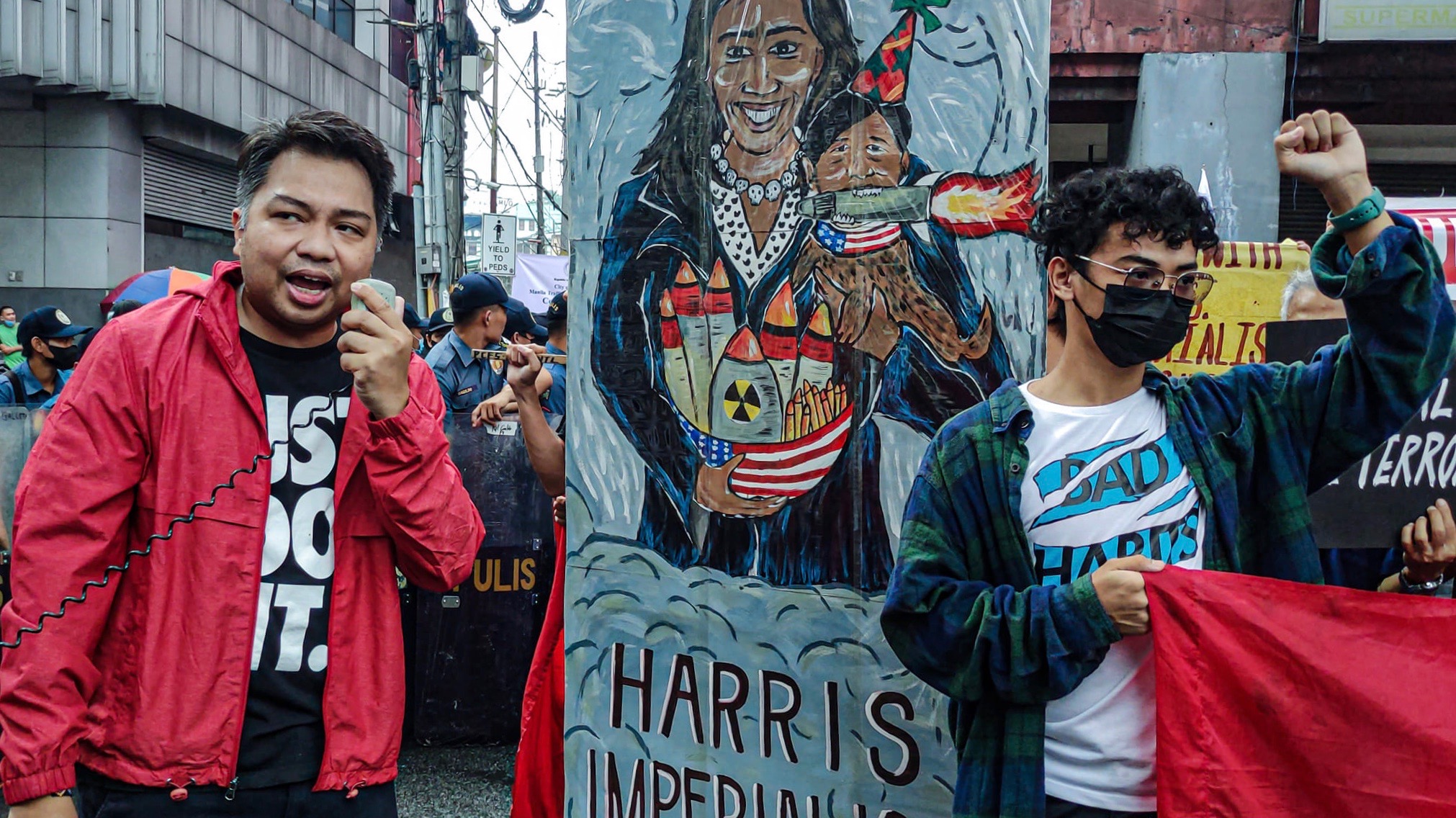United States Vice-President Kamala Harris ended her three-day visit to the Philippines on Tuesday, November 22, amid protests by peace advocates and social movements in the country. Harris is the first top-level US official to visit the Philippines after President Ferdinand “Bongbong” Marcos Jr took office in June earlier this year.
While President Marcos arranged for a warm reception for Harris, social movements received her visit with a massive demonstration to protest the US’ role in the worsening human rights situation in the Philippines.
On Monday, November 21, thousands participated in a massive rally in Manila, organized by several groups under the left-wing progressive coalition Bagong Alyansang Makabayan (Bayan).
Protesters shouted slogans saying that Harris was “Not Welcome” and carried placards and posters against US imperialist policy and its military presence in the country. Protesters were also seen holding a poster with a caricature of Harris and Marcos Jr which read “Harris Imperialist.”
According to reports, a massive battalion of the Philippines National Police blocked the planned march route and even chased protesters when they tried to take a detour. Despite the heavy policing, social leaders and progressives managed to speak at the rally decrying the visit and the impact it will have on the region as a whole.
“Kamala Harris’ visit to the Philippines will bring harm to the country,” said Raymond Palatino, a leader of Bayan and its constituent youth movement Kabataan. “Because her agenda here is not for peace, not for the Philippines’ development, but for additional military bases of the US; additional aid for the military, funds that will be used for corruption, funds for war equipment that will be used against Filipinos.”

Millions for militarization
Just ahead of the visit, the US announced major plans to infuse military aid into the Philippines and further expand US military presence in the region. In October, the US ambassador in Manila announced USD 100 million in foreign military financing for the Philippines “to use as it wishes.”
Rights groups and grassroots activists have raised concerns that such financing could go into continuing the counter-insurgency programs in the country.
“The US cannot evade accountability for the worsening human rights situation in the Philippines,” said Cristina Palabay, secretary general of rights group Karapatan, in a statement released on Monday.
“It already has blood on its hands for having pushed and funded successive regimes in the Philippines, including the Duterte administration, to adopt increasingly vicious counter-insurgency policies resulting in stepped-up attacks against people’s rights and civil liberties.”
The financing is also being viewed as a reward to the Philippines for scrapping a Rodrigo Duterte-era USD 227 million deal for military helicopters from Russia, and instead opting for Chinook helicopters from the US.
Despite US media speculation that the closer ties between the US and Philippines under Marcos Jr is an apparent break from his predecessor’s policies, data shows that the US had provided massive military financing even under Duterte’s regime.

As per official data, the Philippines remained the largest recipient of US military aid and financing between 2015 and 2022. It received funds, arms, equipment and training to the tune of USD 1.14 billion, including foreign military financing of USD 475 million.
Furthermore, just a week ahead of Harris’ visit, the Philippine’s chief of staff of the Armed Forces of the Philippines (AFP) Bartolome Bacarro confirmed that the US wanted to construct five new military facilities in northern Philippines.
These facilities are to be constructed in addition to the five that already exist under a controversial 2014 military pact, the Enhance Defence Cooperation Agreement (EDCA), tying the AFP with the US.
Harris’ visit included agreements about this plan with senior military officials of the Marcos administration. According to Rappler, the US has already agreed to allocate more funds on top of the earlier agreed upon allocation of USD 82 million for EDCA expansion. Sites for the development of new facilities have already been identified.
“Visit to contend with China”
Activists also raised alarm over the anti-China agenda which they claimed is at the heart of the visit, especially the much criticized visit to Palawan province.
The island province is the Filipino territory closest to the disputed Spratly Islands in the South China Sea, parts of which the Philippines claims as part of its territory.
Liza Maza, former legislator and a member of women’s group Gabriela, said that the US conflict with China was at the heart of Harris’ visit. Speaking to the protesters in Manila, Maza argued that “Harris visited the Philippines to contend with China.”
“The United States makes the Philippines enter conflict against China. That’s their projection. That’s why we, being peace-loving people, should reject this US agenda.”
The activists’ concerns were vindicated when Harris made statements targeting China over the multi-national dispute in the South China Sea from a coast guard boat. She also claimed that the US “stands with the Philippines” against what she characterized as “intimidation and coercion in the South China Sea.”
Harris’ visit to the island was the first of its kind ever by a top US official.

Movements also called out the Marcos Jr administration for allowing the US to use the Philippines in its acts of aggression. In a statement, the International League of Peoples’ Struggle-Philippines called out Marcos Jr for continuing in the footsteps of his late father and former dictator Ferdinand Marcos in pursuing a pro-US policy.
“The US imperialist government is no friend of ours,” the statement said. “With its long history of colonization, waging wars of aggression and intervention, and engineering of policies that worsened the economic, political, and cultural lives of the Filipino people – it has never been an ally nor a partner.”
This was echoed by Kilusang Mayo Uno, which said that the talks held between Harris and Marcos Jr “aims to strengthen the so-called US-Philippine alliance; but the Filipino people know that this just means further puppetry to the US neoliberal policies, and intensified curtailment of our rights.”
Hollow platitudes for rights defenders
Faced with such protests from movements, Harris’ itinerary included a meeting organized on the sidelines of her visit with a carefully selected group of social workers and issue-based advocates. During the meeting, she extended solidarity to human rights defenders and advocates of free speech and women’s rights in the Philippines, telling right defenders that they are “not alone.”
However, she failed to mention any measures the US might take in realizing this solidarity. She even failed to mention the recent incidents of violence against rights defenders and journalists in the country, including the high-profile case of independent radio journalist Percy Lapid.
Activists were prompt to call out the hypocrisy in her statements. “By these actions, the US continues its double-speak on human rights, while pursuing its geo-political and military interests in the Philippines and in the Asia Pacific region,” said Palabay, while pointing out Harris’ own history of promoting militaristic and anti-human rights agenda.





